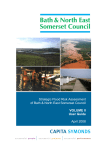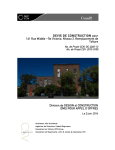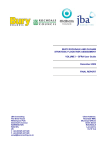Download St Helens Borough Planning User Guide
Transcript
Planners from St Helens Borough Council should carry out the Sequential Test (refer Section 5 of the SFRA) before considering the development of an allocated site Is allocated site within Zone 3b Functional Floodplain? No Yes Yes Is proposed land use categorised as less/more/highly vulnerable in Table D2 of PPS25? Is allocated site within Zone 2 Medium Probability? Yes Yes Is proposed land use categorised as water compatible or less vulnerable in Table D2 of PPS25? No Is proposed land use categorised as water compatible in Table D2 of PPS25? No Is allocated site within Zone 3a High Probability? No Is proposed land use categorised as highly vulnerable in Table D2 of PPS25? Yes Yes No Is proposed land use categorised as essential infrastructure or more vulnerable in Table D2 of PPS25? Yes No Development not permitted according to PPS25 No Yes Exception Test Required (see D9 in PPS25) Need to demonstrate wider sustainability benefits to the community that outweigh flood risk A site-specific FRA should be submitted for all developments in Flood Zone 3b, 3a, 2 and developments >1Ha in Zone 1 St Helens Borough Planning User Guide Development should be on developable previously developed land unless no reasonable alternative sites Planning conditions should be applied to ensure development will be safe without increasing flood risk elsewhere and where possible will reduce flood risk overall No Planning constraints on development according to PPS25 Planning conditions should be applied, appropriate to Flood Zone and land use type, to promote a reduction in overall flood risk and use of sustainable drainage No Unless development is proposed on an allocated site that has been included in The SFRA then the Developer should carry out the Sequential Test (refer Section 5 of the SFRA ) before considering the development of an allocated site Is allocated site within Zone 3b Functional Floodplain? No Is allocated site within Zone 3a High Probability? Yes Yes No Is allocated site within Zone 2 Medium Probability? Yes Is proposed land use categorised as less/more/highly vulnerable in Table D2 of PPS25? Is proposed land use categorised as water compatible or less vulnerable in Table D2 of PPS25? No No Is proposed land use categorised as water compatible in Table D2 of PPS25? Yes No Is proposed land use categorised as highly vulnerable in Table D2 of PPS25? Yes Yes No Is proposed land use categorised as essential infrastructure or more vulnerable in Table D2 of PPS25? No No Development not permitted according to PPS25 Yes Yes Exception Test Required Demonstrate wider sustainability benefits to the community that outweigh flood risk Development should be on developable previously developed land unless no reasonable alternative sites Developer User Guide A site-specific FRA should be provided which demonstrates that the flood risk to the site can be mitigated for the lifetime of the development and there is no increase in flood risk elsewhere and if possible a reduction in flood risk overall Development is appropriate. A site-specific FRA should be provided for all developments which demonstrates that the flood risk to the site can be mitigated for the lifetime of the development and there is no increase in flood risk elsewhere Development is appropriate. A site-specific FRA should be submitted for all developments >1Ha in Zone 1 Low Probability. A site-specific FRA should concentrate on drainage impacts to ensure the development does not exacerbate localised surface water flooding issues. Guidance Notes for Developers How to Use the Strategic Flood Risk Assessment The Strategic Flood Risk Assessment is the assessment and categorisation of flood risk on a district wide basis in accordance with PPS25. SFRAs refine information on the probability of flooding, taking other sources of flooding and the impacts of climate change into account. The SFRA provides the basis for applying the Sequential Test and the Exception Test where consideration needs to be given to the impact of the flood risk management infrastructure on the frequency, impact, speed of onset, depth and velocity of flooding within the Flood Zones considering a range of flood risk management maintenance scenarios. A developer should consider flood risk issues at a site as early as possible. The SFRA can be used to provide an indication of the likely flood risk issues at a site from all sources of flooding. Developers should identify whether the development site has been allocated for that type of land use in the Local Development Documents. For allocated sites the SFRA can provide information on the application of the Sequential Test and where undertaken the Exception Test to see if the land use is appropriate. When is a Flood Risk Assessment Required? A Flood Risk Assessment (FRA) will be required to accompany planning applications for: • any development proposals of I hectare or greater in Flood Zone 1 • any development proposals in Medium Probability Flood Zone 2 • any development proposals in High Probability Flood Zone 3 The FRA should identify and assess the risks of all sources of flooding to and from the development, taking into account climate change and demonstrate how the risk will be managed. A FRA will also be required where the proposed development or change of use to a more vulnerable class may be subject to other sources of flooding or where the Environment Agency, Internal Drainage Board and/or other bodies have indicated that there may be drainage problems. Standard Flood Risk Management Guidance for Developers The broad aim of the Planning Policy Statement 25 is to reduce the number of people and properties within the natural and built environment at risk of flooding. To achieve this aim, planning authorities are required to ensure that flood risk is properly assessed during the initial planning stages of any development. Responsibility for this assessment lies with developers and they must demonstrate the following: • Whether the proposed development is likely to be affected by current or future flooding from any source. • Whether the proposed development will increase flood risk elsewhere. • Whether the measures proposed to deal with any flood risk are sustainable. The developer must prove to the Local Planning Authority and the Environment Agency that the existing flood risk or flood risk associated with the proposed development can be satisfactorily managed. The detail to be provided by a FRA will depend on where the proposed site fits within the development framework, particularly on its justification against the sequential test, described in the SFRA. Development should follow the standard flood risk assessment approach provided by the Environment Agency and Ciria, as follows: • National Standing Advice to Local Planning Authorities for Planning Applications Development and Flood Risk in England’ (June 2004) • CIRIA Report C624 “Development and Flood Risk – Guidance for the Construction Industry” (2004). The general requirements of a FRA are listed in Appendix E of PPS25 and within the Practice Guide to PPS25. Further guidance on the level of detail required for a FRA can be found in the Environment Agency’s Flood Risk Assessment guidance notes available at http://www.pipernetworking.com/floodrisk/index.html Guidance for Development within Each Flood Zone An FRA should be commensurate with the risk of flooding to the proposed development. For example, where the risk of flooding of the site is negligible (Zone 1 Low Probability) there is little benefit to be gained in assessing the potential risk to life and/or property as a result of flooding. The particular requirements for FRAs within each of the flood zones delineated within PPS25 are outlined below. Flood Zone 1 Low Probability There are generally no flood risk related constraints placed upon future development within Zone 1 Low Probability according to PPS25; however it is important to recognise that if development is not carefully managed within this zone it may adversely affect the existing flooding regime. The risks of alternative sources of flooding (e.g. groundwater, pluvial) need to be considered. The proposed development should also consider surface water runoff to ensure that there are no detrimental effects to existing development and where possible the runoff is reduced through sustainable drainage systems. Flood Zone 2 Medium Probability To satisfy the requirements of the Sequential Test, PPS25 recommends that development within Flood Zone 2 should be restricted to ‘essential infrastructure’, ‘water compatible’, ‘more vulnerable’ or ‘less vulnerable’ land uses. Where non-flood risk related planning matters dictate that highly vulnerable development should be considered further within Flood Zone 2 it will be necessary to carry out the Exception Test. PPS states that for the Exception Test to be passed: 1. it must be demonstrated that the development provides wider sustainability benefits to the community that outweigh flood risk, informed by a SFRA where one has been prepared. 2. the development should be on developable, previously-developed land or, if it is not on previously developed land, that there are no reasonable alternative sites on developable previously-developed land; and 3. a FRA must demonstrate that the development will be safe, without increasing flood risk elsewhere, and, where possible, will reduce flood risk overall. The risks of alternative sources of flooding (e.g. groundwater, pluvial) need to be considered. The proposed development should consider surface water runoff to ensure that there are no detrimental effects to existing development and where possible the runoff is reduced through sustainable drainage systems. As part of the FRA, it will be necessary to demonstrate that the residual risk of flooding can be effectively managed and a planned evacuation route or safe haven can be provided. Flood Zone 3a High Probability To satisfy the requirements of the Sequential Test, PPS25 recommends that development within Flood Zone 3a should be restricted to ‘Less Vulnerable’ and ‘Water Compatible’ land uses. Where non-flood risk related planning matters dictate that ‘more vulnerable’ vulnerable development and ‘Essential Infrastructure’ should be considered further within Flood Zone 3a it will be necessary to carry out the Exception Test (see above for details). An FRA should include the following: • • • • • The vulnerability of the development to fluvial and/or tidal flooding as well as other sources. The impact of climate change over the lifetime of the development on the flooding regime, i.e. maximum water levels, flood extents and flow paths. The effect of the new development on surface water runoff ensuring that there are no detrimental effects to existing development and where possible that runoff is reduced through sustainable drainage systems. Demonstration that residual risks of flooding, after existing and proposed flood management and mitigation measures are taken into account, are acceptable. Demonstration that dry access can be provided to enable the safe evacuation in the case of flooding or where this is not achievable a safe haven can be provided. Flood Zone 3b Functional Floodplain To satisfy the requirements of the Sequential Test, PPS25 recommends that development within Flood Zone 3b should be restricted to ‘water compatible’ land uses. Where non-flood risk related planning matters dictate that ‘Essential Infrastructure’ should be considered further within Flood Zone 3b it will be necessary to carry out the Exception Test (see above for details). An FRA should include the following: • • • • • The vulnerability of the development to fluvial and/or tidal flooding as well as other sources. The impact of climate change over the lifetime of the development on the flooding regime, i.e. maximum water levels, flood extents and flow paths. The effect of the new development on surface water runoff ensuring that there are no detrimental effects to existing development and where possible that runoff is reduced through sustainable drainage systems. Demonstration that residual risks of flooding, after existing and proposed flood management and mitigation measures are taken into account, are acceptable. Demonstration that dry access can be provided to enable the safe evacuation in the case of flooding or where this is not achievable a safe haven can be provided. Additional Guidance Undefended Floodplain Areas at risk of fluvial flooding need to be assessed against the 1% annual exceedance probability (AEP) criteria with 0.5% AEP criteria for tidal flooding. The Environment Agency’s hydraulic models may be made available for use by developers to determine the site’s vulnerability to flooding. . The developer will need to firstly ensure that the models are fit for purpose and sufficiently detailed to provide an accurate understanding of flood risk to the site. If existing models are not available, then a developer will need to assess the extent and requirements of any modelling work that is required. Detailed hydraulic modelling will involve the following: • • • • • • Carrying out a hydrological assessment using Flood Estimation Handbook techniques and using gauging records where available. Constructing an in-bank model using up to date survey data including structures, e.g. bridges, weirs, culverts and sluices. Extending the in-bank model to include floodplains where necessary using appropriate hydraulic modelling approaches to replicate the extent, storage and conveyance of the floodplains, e.g. through extended cross sections, reservoir units or 2-D modelling. Calibrating or verifying the hydraulic model where hydrometric monitoring data or flood records are available. Carrying out sensitivity analysis to confirm modelling assumptions and assess climate change impacts. Mapping of flooding extents Defended Floodplain Development sites within a defended tidal or fluvial floodplain are at particular risk due to the risk of the defences being overtopped or breached, resulting in the rapid onset of fast flowing and deep water flooding with little or no warning. Residual risk from the breach or overtopping of defences needs to be considered as part of a FRA. Defra’s1 Flood Risk Assessment Guidance for New Development provides guidance on the level of risk related to distance and flood depth for overtopping and breaching scenarios. The objectives of a breach analysis are as follows: • to determine the Rapid Inundation Zone where there is a potential risk to life • to investigate the impact of the proposed development on the flood risk to others • to test the effectiveness of mitigation measures Consideration of flood risk behind defences should take into consideration the standard of protection and design freeboard of the flood defence along with its condition and potential mechanisms of failure. The parameters of a breach in terms of potential location, width and invert level as well as the duration of a flood event should be agreed with the Environment Agency prior to any analysis. Design Floor Levels It may be feasible to reduce the risk to a development through raising the ground level above the level of flood risk. Floor levels should be raised above the 1% AEP fluvial flood level plus an allowance for climate change assuming a 20% increase in flow over the next 100 years. For coastal flood risk, floor levels should be raised above the 0.5% AEP plus climate change. Climate change predictions for rises in sea level vary across the country and should be based 2 on Defra guidance. In addition, the design flood level should include a freeboard above the flood level. For nonresidential development, e.g. commercial freeboard, the Environment Agency usually requires a freeboard of 300mm, and for residential development a freeboard of 600mm. 1 Flood Risk Assessment Guidance for New Development Phase 2: Framework and guidance for Assessing and Managing Flood Risk for New Development – Full Documentation and Tools. R&D Technical Report FD2320/TR2. Defra/Environment Agency 2005 2 Flood and Coastal Defence Appraisal Guidance FCDPAG3 Economic Appraisal Supplementary Note to Operating Authorities – Climate Change Impacts. Defra, October 2006 Compensatory Storage Where development is proposed in undefended areas of floodplain, which lie outside of the functional floodplain, the implications of ground raising operations for flood risk elsewhere needs to be considered. Raising existing ground levels may reduce the capacity of the floodplain to accommodate floodwater and increase the risk of flooding by either increasing the depth of flooding to existing properties at risk or by extending the floodplain to cover properties normally outside of the floodplain. Flood storage capacity can be maintained by lowering ground levels either within the cartilage of the development or elsewhere in the floodplain, in order to maintain at least the same volume of flood storage capacity within the floodplain. In undefended tidal areas, raising ground levels is unlikely to impact on maximum tidal levels so the provision of compensatory storage should not be necessary. For development in a defended flood risk area, the impact on residual flood risk to other properties needs to be considered. New development behind flood defences can increase the residual risk of flooding if the flood defences are breached or overtop by changing the conveyance of the flow paths or by displacing flood water elsewhere. If the potential impact on residual risk is unacceptable then mitigation should be provided. Surface Water Drainage Assessment Developers should demonstrate that the disposal of surface water from the site will not exacerbate existing flooding from new development within Flood Zones 3 and 2, development greater than 1Ha in Flood Zone 1 and within areas that are known to suffer from surface water drainage or sewer flooding. A surface water drainage assessment should be undertaken to demonstrate that surface water runoff from the proposed development can be effectively managed without increasing flood risk elsewhere. A surface water drainage assessment should include the following: • • • • • Assessment of whether the development will increase the overall discharge from the site by calculating the change in area covered by roofs and hard-standing. Details of how overland flow from the new development can be intercepted to prevent flooding of adjacent land. Details of how additional onsite surface water attenuation can be provided to mitigate against known flooding problems or as a result of incapacity on the drainage systems. Demonstration that overland flows will not increase flood risk to both existing development and receiving watercourses. Agreement that the rates of discharge from the development are acceptable to the Environment Agency and utilities authorities. Selection of Appropriate Mitigation Measures The sequential approach should be applied within development sites to locate the most vulnerable elements of a development in the lowest risk areas. Where vulnerable development cannot be allocated within low risk areas then measures could be put in place to mitigate against the flood risk. There are several sources of information on potential mitigation measures, as follows: • • Flood Risk Assessment Guidance for New Development, Environment Agency R&D (FD2320) Development and Flood Risk – Guidance for the Construction Industry, CIRIA 624 The Environment Agency R&D Guidance on Flood Risk Assessments for new development suggests that mitigation measures can be split into three types: • • • Measures that reduce the physical hazard, e.g. through raised defences or flood storage Measures that reduce the exposure to the hazard, e.g. raise properties above flood levels Measures that reduce the vulnerability to the hazard, e.g. flood warning or emergency planning. The selection of appropriate mitigation measures depends on the requirements of the development and its sensitivity to flood risk. Any mitigation measure selected should be sustainable in the future by taking into consideration the impact of climate change on flood risk. The residual risk of developing an area vulnerable to flooding with mitigation measures in place should also be considered. Flood defence walls or embankments Flood defences, fully funded by the development can be constructed to protect a new development. However, the impact on the risk of flooding elsewhere with defences in place needs to be assessed and managed for example through compensatory storage. Residual risk of flooding with flood defences also needs to be assessed and managed. It is acknowledged that this mitigation measure does introduce potential maintenance issues and as a result is not a favoured approach by the Environment Agency. If this measure is to be investigated, the site specific FRA should identify a long term maintenance plan and determine associated residual risks. Chapter 6 of the PPS25 Practice Guide provides further advice on residual risk behind defences. Flood Storage Flood storage either offline or online can be used to manage water levels at or downstream of a development site. Building Design Flood management measures only manage the risk of flooding rather than remove it completely. Therefore, buildings should be designed to be flood resistant and flood resilient where they are built behind flood defence systems. Flood resistance is the prevention of flood water entering a building through, for example, flood barriers or raising floor levels. Flood resilience is ensuring the finish (e.g. type of flooring) and services (e.g. electrics) are such that following a flood the building can be returned quickly to its normal operation. A basic level of flood resistance and resilience can be achieved through good building practice and complying with Building Regulations (ODPM, 2000). Flood Warning The Environment Agency provides flood warnings to a number of existing properties at risk of flooding to enable owners to protect life and manage the effect of flooding of their property. Flood warning should only be provided as a measure to manage residual risk and should not be used as the sole measure to offer protection to a development. Access and Egress PPS25 requires that safe access and escape is available to and from new developments in flood risk areas. Where possible, safe access routes should be located above design flood levels and an evacuation procedure should be in place for an extreme flood event. If no safe access can be provided then a safe haven should be provided within the development. St Helens Strategic Flood Risk Assessment. Flood Risk Fact Sheet For: Billinge Legend River Centrelines Hydraulic Model Flood Risk EA Flood Map 2 EA Flood Map 3 Surface Water Flooding Fire and Rescue Flooding Previous Modelling Studies: - No studies identified. Historic Flood Risk Information: - No reported historic flood event information. Potential Flood Risk Sources: - Main source of flood risk likely to be Black Brook although limited impact to Billinge. St Helens Strategic Flood Risk Assessment. Flood Risk Fact Sheet For: Haydock Legend River Centrelines Hydraulic Model Flood Risk EA Flood Map 2 EA Flood Map 3 Surface Water Flooding Fire and Rescue Flooding Previous Modelling Studies: - Sankey Brook Flood Risk Mapping Study. Rivers covered include Black Brook. - Black Brook Flood Alleviation Scheme included modelling of Black Brook. Historic Flood Risk Information: - Fire Service assisted with localised flood incident to property at Haydock Cross, 2005 Potential Flood Risk Sources: - Main source of fluvial flood risk is Clipsley Brook and Black Brook. St Helens Strategic Flood Risk Assessment. Flood Risk Fact Sheet For: Newton-le-Willows Legend River Centrelines Hydraulic Model Flood Risk EA Flood Map 2 EA Flood Map 3 Surface Water Flooding Fire and Rescue Flooding Previous Modelling Studies: - Sankey Brook Flood Risk Mapping Study. Rivers covered by study include Sankey and Netwon Brooks. Historic Flood Risk Information: - Fire Service assisted localised flooding incident at St Alfreds School, 2006 Potential Flood Risk Sources: - Main source of fluvial flood risk are Newton and Sankey Brooks. St Helens Strategic Flood Risk Assessment. Flood Risk Fact Sheet For: Rainford Legend River Centrelines Hydraulic Model Flood Risk EA Flood Map 2 EA Flood Map 3 Surface Water Flooding Fire and Rescue Flooding Previous Modelling Studies: - No studies identified. Historic Flood Risk Information: - Fire Service called to incident of surface water flooding affecting residential properties as a result of overland flow from fields (2005). - Approximately 11 properties at risk of flooding in the Lower Shades area upstream of Beech Gardens. Reported that flooding associated with capacity and blockage of existing culvert. Potential Flood Risk Sources: - Main sources of fluvial flood risk are Rainford Brook. - Potential for flooding as a result of surface water and overland flow. St Helens Strategic Flood Risk Assessment. Flood Risk Fact Sheet For: Rainhill Legend River Centrelines Hydraulic Model Flood Risk EA Flood Map 2 EA Flood Map 3 Surface Water Flooding Fire and Rescue Flooding Previous Modelling Studies: - No studies identified. Historic Flood Risk Information: - Flooding associated with blockage of the Pendlebury Brook culvert at the Ibstock brick works site. Potential Flood Risk Sources: - Main source of fluvial flood risk is Pendlebury Brook. St Helens Strategic Flood Risk Assessment. Flood Risk Fact Sheet For: St Helens Area 1 Legend River Centrelines Hydraulic Model Flood Risk EA Flood Map 2 EA Flood Map 3 Surface Water Flooding Fire and Rescue Flooding Previous Modelling Studies: - Sankey Brook Flood Risk Mapping Study. Rivers covered by study include lower reaches of Rainford Brook, Windle Brook and Hardshaw Brook Historic Flood Risk Information: - Approximately 50 houses flooded in the viscinity of Denton's Green due to constrictions to flow in Rivington Culvert. - During 1980's, prior to construction of flood defences, flooding observed at confluence of Mill and Windle Brooks, date unknown. - Surface water flooding occurs on College Lane Potential Flood Risk Sources: - Main sources of fluvial flood risk are Windle and Rainford Brooks. - Localised surface water flood risk. St Helens Strategic Flood Risk Assessment. Flood Risk Fact Sheet For: St Helens Area 2 Legend River Centrelines Hydraulic Model Flood Risk EA Flood Map 2 EA Flood Map 3 Surface Water Flooding Fire and Rescue Flooding Previous Modelling Studies: - Sankey Brook Flood Risk Mapping Study. Rivers covered by study include Black, Sankey and Rainford Brooks. - Black Brook Flood Alleviation Scheme, modelling coverage incudes Black Brook Historic Flood Risk Information: - Flooding in 2000 to approximately 12 properties in the West End Road area, 2000. - Fire Service provided assistance to vehicle stranded in ponded flood water on College Street in 2004 Potential Flood Risk Sources: - Main sources of fluvial flood risk are Black, Sankey and Rainford Brooks. - Carr Mill Dam potential source of flood risk although mitigated through maintenance and inspection. - Localised surface water flood risk. - Potential for flooding from the canal during high order events. St Helens Strategic Flood Risk Assessment. Flood Risk Fact Sheet For: St Helens Area 3 Legend River Centrelines Hydraulic Model Flood Risk EA Flood Map 2 EA Flood Map 3 Surface Water Flooding Fire and Rescue Flooding Previous Modelling Studies: - Sankey Brook Flood Risk Mapping Study. Rivers covered by study include Lower reach of Windle Brook and Hardshaw Brook. Historic Flood Risk Information: - Surface water flooding affecting College Lane and Peasley Cross Lane. Unknown date. - Fire Service provided assistance to localised flooding incidents in viscinity of town centre (2004, 2005, 2006). Potential Flood Risk Sources: - Main sources of fluvial flood risk are Hardshaw, Mill and Windle Brooks. - Localised surface water flood risk - Flood risk potential from Mill Dam, Eccleston Top and Bottom Dams and Groves Dam. Risk mitigated through routine maintenance and inspection. St Helens Strategic Flood Risk Assessment. Flood Risk Fact Sheet For: St Helens Area 4 Legend River Centrelines Hydraulic Model Flood Risk EA Flood Map 2 EA Flood Map 3 Surface Water Flooding Fire and Rescue Flooding Previous Modelling Studies: - Sankey Brook Flood Risk Mapping Study. Rivers covered by study include Sankey, Black, Rainford, Hardshaw and Sutton Brooks. - Black Brook Flood Alleviation Scheme, modelling coverage incudes Black Brook Historic Flood Risk Information: - Surface water flooding affecting College Lane and Peasley Cross Lane. Unknown date. - Localised flooding of 15 properties on Gerards Lane. Unknown date. - Fire Service provided assistance to localised flooding incidents (2004 and 2006). Potential Flood Risk Sources: - Main sources of fluvial flood risk are Sutton, Hardshaw, Sankey, Rainford and Black Brooks. - Localised surface water flood risk

































